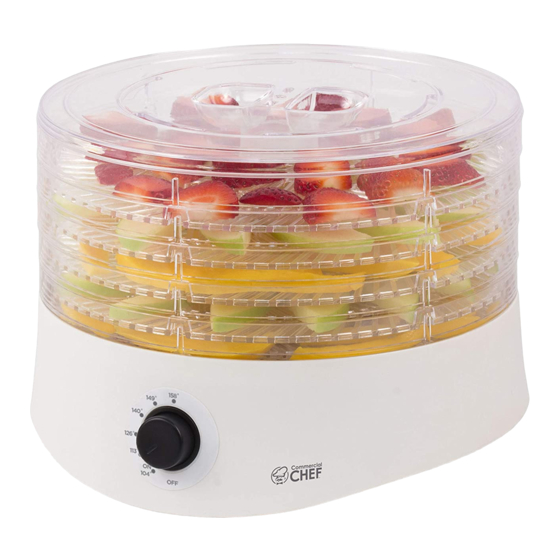
Table of Contents
Advertisement
User Manual
Food Dehydrator
MODEL: CCD100W6
1. READ these instructions carefully before installing and operating the
appliance. Keep them for further reference.
2. Record in the space below the "SERIAL/MODEL NUMBER" found on the back
or bottom of your appliance and retain this information for future reference.
SERIAL NUMBER:
MODEL NUMBER:
DATE OF PURCHASE:
Save and staple your sales receipt to your manual for warranty coverage.
Page 1
Advertisement
Table of Contents

Summary of Contents for Commercial CHEF CCD100W6
- Page 1 User Manual Food Dehydrator MODEL: CCD100W6 1. READ these instructions carefully before installing and operating the appliance. Keep them for further reference. 2. Record in the space below the “SERIAL/MODEL NUMBER” found on the back or bottom of your appliance and retain this information for future reference.
-
Page 2: Table Of Contents
CONTENTS SAFETY INFORMATION Important Safety Instructions ............................3 Polarized Plug ....................................4 SET UP & USE Parts & Features ..................................5 Operation Instructions ................................6 Dehydration Guide ................................7-11 Drying Tables for Fruits .................................12 Drying Tables for Vegetables .............................13 CLEANING & CARE ............................. 14 TROUBLESHOOTING &... -
Page 3: Safety Information
SAFETY INFORMATION DANGER WARNING CAUTION DANGER - Immediate hazards WARNING - Hazards or unsafe CAUTION - Hazards or unsafe which WILL result in severe practices which COULD result in practices which COULD result in personal injury or death severe personal injury or death minor personal injury IMPORTANT SAFETY INSTRUCTIONS WARNING... -
Page 4: Polarized Plug
2. The cord shall be arranged so that it will not dape over the countertop where it can be pulled on by children or tripped over unintentionally. NOTE: Neither Commercial Chef nor the dealer can accept any liability for damage to the product personal injury resulting from failure to observe the electrical connection procedures. -
Page 5: Set Up & Use
SET UP & USE PARTS & FEATURES Detachable Trays Base Power / Temperature Selector Control BEFORE FIRST TIME USE • Remove all packaging from the appliance. • Check that your mains voltage corresponds with that stated on the appliances rating label. •... -
Page 6: Operation Instructions
SET UP & USE TO BEGIN USE 1. Place the food flat on the trays. Do not completely cover the bottom of the tray as this will stop the air circulation. Overloading the trays or placing the food on top of each other will reduce the efficiency of the dehydrator. -
Page 7: Dehydration Guide
SET UP & USE DEHYDRATION GUIDE PRINCIPLES OF DEHYDRATION There are no absolutes and quite a few variables in food dehydration. The best way to become proficient is to experiment using this booklet as a guideline and then adjusting your drying technique according to your results. Record keeping is helpful in food dehydration. - Page 8 SET UP & USE PRETREATING Enzymes in fruit and vegetables are responsible for color and fl avor changes during ripening. These changes will continue during drying and storage unless the produce is pretreated to slow down enzyme activity. Blanching can be used in the pretreatment of vegetables, as it helps set color and hastens drying by relaxing tissues.
- Page 9 SET UP & USE RECONSTITUTING FOODS All dehydrated foods need to be reconstituted. Most fruits are actually preferable in their dried form. Most vegetables, however, are most taste-tempting when reconstituted. To reconstitute vegetables for cooking, merely wash product in clean water, then place in an amount of cold, unsalted water and cover.
- Page 10 SET UP & USE One cup of dried fruit reconstitutes to about 1 1/2 cups. Add water just to cove the fruit; more can be added later if needed. One to eight hours are required to reconstitute most fruits, depending on fruit type, size of pieces, and water temperature.
- Page 11 SET UP & USE PACKING AND STORAGE Fruits cut into a wide range of sizes should be allowed to “sweat” or condition for a week after drying to equalize the moisture among the pieces before placing in long- term storage. Place fruit in a non-aluminum, non-plastic container and put in a dry, well-ventilated and protected area.
-
Page 12: Drying Tables For Fruits
SET UP & USE DRYING TABLE FOR FRUITS The times are approximate. Your drying times will vary with room temperature, humidity, moisture content of the food and how thinly the food is sliced. The presence of natural juices in food will also vary. Some fruit sugars tend to be sticker than others. -
Page 13: Drying Tables For Vegetables
SET UP & USE DRYING TABLE FOR VEGETABLES The times are approximate. Your drying times will vary with room temperature, humidity, moisture content of the food and how thinly the food is sliced. The presence of natural juices in food will also vary. Dry best at 125˚F / 52˚C . Adjust temperatures as needed. -
Page 14: Cleaning & Care
CLEANING AND CARE CLEANING THE UNIT Before cleaning switch off the appliance and remove the mains plug from the wall socket. Clean with a soft, dry or damp cloth, if required with a neutral detergent. Do not use any abrasive cleaning agents, scourers etc. to clean the appliance. Wash the drying trays and top lid in hot water, clean with neutral detergent, rinse in potable water and let them dry. -
Page 15: Limited Warranty
TROUBLESHOOTING & WARRANTY LIMITED WARRANTY Commercial Chef brand is used under license. 13. Labor after the initial 12 months. 14. Food loss for loss due to product Any repair, replacement, or warranty service, failure or delay in service, repair or and all questions about this product should be replacement. - Page 16 © 2018 Commercial Chef is a W Appliance Company. All Rights Reserved. 083018 Page 16...



